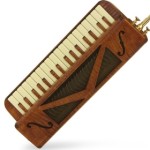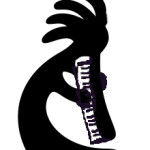Shoulder strap?
- This topic has 16 replies, 8 voices, and was last updated 6 years, 11 months ago by
Paul Durham.
-
AuthorPosts
-
April 13, 2016 at 11:03 pm #7067
Gayle H
ParticipantHello, this is my first post. I bought a melodica a month ago (already play piano, accordion, and flute, easy to transfer skills) and have been watching Youtube videos to get inspired on technique. I watched a video by the Tokyo Melodica Orchestra and noticed players with a shoulder strap that allows them to use both hands to play. I started doing searches for melodica shoulder straps but without success. I also wonder how it would be attached. At the top of the back of the melodica (Hohner Performer 37) is a thingy where one end of a strap might be attached, but there is none on the bottom. Anyone have any suggestions about where to get one (or should I try to make one?) and how to attach them? Thanks in advance.
April 14, 2016 at 6:28 am #7068 QuetscherParticipant
QuetscherParticipantHello and welcome Gayle,
the Tokyo guys that use straps mostly play the Hammond 44 which has attachments for a guitar strap. I modified a wooden MyLodica that way and some time ago I equipped my Vibrandoneon with accordion straps, but that’s quite difficult with a plastic melodica. I noticed that my Hohner Fire has the same sort of eye at its back as your Hohner Performer, and I was able to attach a key chain with a karabine. Maybe that’ll help…
Greetings, Quetscher
April 14, 2016 at 1:53 pm #7069 Melodica-MeParticipant
Melodica-MeParticipantI guess the best person to ask would be Akeo. Akeo can you give Gayle some advice on how you connect your strap to your melodion.
Thanks
Melodica-MeApril 14, 2016 at 8:06 pm #7070Gayle H
ParticipantThanks for the suggestions. Guitar strap, keychain, maybe camera strap … no wonder search on “melodica strap” doesn’t turn up anything … except that it brought me to this forum!
With only one, okay I guess “eye” is the name for the thingy, whatever is used would have to just go around the arm or the neck, I guess it would be playable that way, (I’ve been searching these forums for threads on two-handed playing, so far haven’t found any.)
But here is another question. Apparently people do take their melodicas apart for purposes such as tuning. If I took this plastic melodica apart and carefully drilled some holes to make it possible to create another attachment, would that affect the sound or volume of the melodica, to have those tiny holes? If I ran a shoelace through the holes and they completely filled the holes, would that prevent any change in sound? (I’m a little concerned that the single eye on this plastic melodica looks sort of fragile and might break off if I wasn’t very careful in using some sort of strap, keychain, etc.)
Thanks again for help and suggestions!
April 15, 2016 at 7:20 am #7088 QuetscherParticipant
QuetscherParticipantAs long as you don’t drill into a part that should be airtight there’s no problem…
April 15, 2016 at 6:37 pm #7094Gayle H
ParticipantWell, I don’t know enough about the melodica to know what parts are supposed to be airtight…
But I just watched a video of Jon Batiste, in which an interviewer asked if it bothered him to only be able to use one hand to play, and he said, “No, I don’t think of this as a piano, I think of it as a horn.”
That clicked with me. The melodica may look like a little piano, but it is really a wind instrument and should be approached as a wind instrument.
As a beginning melodica player, I shouldn’t already be trying to mess around with changing the instrument. (Even though learning to play the keys backward with the left hand seemed like a fun challenge). I should pay attention to the fact that no one on this board seems to be talking about two-handed playing. Why? Because it is not a piano. It doesn’t sound like a piano, feel like a piano, or respond like a piano. It’s really a type of woodwind and that’s how I should be approaching it. Right?
April 15, 2016 at 7:03 pm #7095 QuetscherParticipant
QuetscherParticipantWell, to me the melodica is a hybrid between a keyboard and a wind instrument, so why not at least consider the polyphonic possibilities of the melodica? I agree with you that the melodica is not built primarily to be played two-handed, but there are musical contexts in which you will love to be able to play with two hands. So I would say: don’t be discouraged from the start, try out all the possibilities this fantastic instrument offers!
April 15, 2016 at 8:31 pm #7096Gayle H
ParticipantOkay, now you are making me think about the two-handed playing again! Do you do that? Are there threads here about that? I haven’t been able to find any.
Maybe this question should go in the Technique section, but I find that when I add chords or harmony notes to the melody I am playing, the extra notes seem loud and intrusive, and it is suddenly twice or three times as loud when twice as many or three times as many notes are being played, which throws off the dynamics. I suppose with practice I can learn to compensate for that by altering my breathing, but it seems hard to blend harmony notes smoothly. That is something that is making me think of this more as just a melody instrument… maybe it is called “melodica” for a reason!
Or maybe it is just that I am a beginner and just beginning to know the instrument.
April 17, 2016 at 11:41 am #7104 QuetscherParticipant
QuetscherParticipantGayle, you’re completely right with your observations about adding notes to the melody, it is in fact a tricky business and you will find out that you are not able to do some things that you could do on a piano, for example emphasize a certain line. And when you play chords or counterpoints there is a certain chance for small distortions of the sound, so you have to be very cautious with that. There doesn’t exist a thread for two-handed playing but we have discussed the matter several times in other threads – apart from that (as you have already discovered) people like Lowboy have posted great sound material to analyze and learn from. And yes, I wanted to make you think about two-handed playing again!!!
BTW: I remember having posted an example for two-handed playing quite a long time ago…
April 18, 2016 at 2:13 pm #7121 DarenKeymaster
DarenKeymasterHi Gayle, I agree with Quetscher.
The melodica is a very new instrument (born in 1958), and it’s still finding its feet, in terms of how to play it, what to play on it, performance techniques, how it can be modified and developed…
So have some fun trying things out, and develop your own style at the same time!
April 18, 2016 at 9:39 pm #7126 KevinParticipant
KevinParticipantHi Gayle,
I think most of the Japanese two handed players seem to gravitate to a saxophone or other woodwind type strap. These usually end in a small snapping hook that will sometimes match the eyelet or otherwise hook onto the hand strap.
As far as hole drilling on most Asian made melodicas there is a plastic shell and then an inner air chamber. it should be fine to drill the outer shell. In fact I usually play with mine off:
HOWEVER! If you are talking about the Hohner Performer 37 the lower part of the shell is the air-chamber so proceed with CAUTION.
On to two-handed playing. Although it has a keyboard (take it from an organist from way back) playing the melodica is nothing like the piano. Your breath is filling the air-chamber, when you press on keys you are opening valves that let the air out and it all comes out evenly so there is no real difference in volume. The lower notes have larger reeds that will vibrate with less pressure so they sound first and louder. Sometimes I’ve even had the low notes rob the air from the melody and it not even sound.
I’ve been noticing some players starting to play two melodicas at once to overcome this. Much as there are two manuals on most organs. https://www.youtube.com/watch?v=EoCnnp2Qx64I’d reccomend a little table-top playing at first to get an idea what works and doesn’t before trying the left hand over technique.
April 19, 2016 at 10:31 am #7128 QuetscherParticipant
QuetscherParticipantHi Kevin,
I have never thought about this being a reason for playing two melodicas at once, but yes! that sounds absolutely logical to me. You might even be able (with a little bit of practice) to accentuate one side by directing your airstream a little stronger into one mouthpiece than into the other (at least if there are two mouthpieces and not a single combined one…)
April 19, 2016 at 5:44 pm #7129Gayle H
Participantour breath is filling the air-chamber, when you press on keys you are opening valves that let the air out and it all comes out evenly so there is no real difference in volume. The lower notes have larger reeds that will vibrate with less pressure so they sound first and louder. Sometimes I’ve even had the low notes rob the air from the melody and it not even sound.
Yes, that’s it, when I play a chord the lower-pitched notes overpower the higher-pitched melody notes and it is difficult to achieve a balance. I thought that a melodica would be just like playing the keyboard side of an accordion, which I also play. After all, it uses accordion reeds? And air pressure? Should be the same, right? On ab accordion, you can play chords on the keyboard side just fine and it sounds good, some accordionists even only play the keyboard side and never touch the bass buttons. But what I figured out is that the airflow on the melodica is not hitting all the reeds equally like it does on the accordion. Since the blowhole is on the bottom (near the lowest pitched keys) those lowest pitched notes are going to get the first air and the most air. So the lowest-pitched notes will play most forcefully when two or more notes are played together. I don’t think that it is that the lowest pitched notes have the most sensitive reeds (because otherwise the same thing would happen when you play chords on an accordion keyboard — the melodica does use accordion reeds, right?). I think that it is because the airflow hits the lowest pitched notes first on the melodica. And unlike a piano, you can’t control the dynamics of different notes separately. But I’m studying techniques on the recordings posted. Every instrument has its strengths and limitations, and you have to discover them and adapt to them.
April 19, 2016 at 9:29 pm #7130 KevinParticipant
KevinParticipantHi Quetstcher,
I’m thinking if I was really dedicating two melodicas to that use and they were identical models I would probably mute the accompaniment unit with some cloth or Styrofoam inside or at least tape over the vents? That or make sure the lead instrument was generally louder in the first place.
Definitely worth some experimenting on.
Hmmm, I wonder about hooking the two hoses to a three-way valve?—————————————————————————————-
Hi Gayle,Actually most of the melodicas we see today have harmonica type reeds and not accordion ones. I believe the Vibrandoneon is about the only one currently using accordion reeds. Check with some of the other members on that.
Correct me if I’m wrong? Those keyboard side only accordion players they are playing with one hand and pumping the bellows with the other?
I would think that style of playing where you are adding harmony notes below the melody line in close voiced triads should work pretty well on the melodica?You are probably right that it’s direction of airflow and not reed size that causes the note robbing. However I have had the same effect happen on a reed organ (especially if the bellows are leaking) where a full left-handed chord robs enough air the melody notes don’t sound. The pump organs like the accordion has the air flow to each reed evenly?
April 22, 2016 at 3:07 am #7137 LowboyParticipant
LowboyParticipantJust because the air entrance hole is near the low notes does not mean that the air enters the air chamber near the low notes. While this is often the case, in some melodicas, air travels well over 30 inches from the entrance hole and passes over the high notes before reaching the low notes.
The low notes still rob air from the high notes. The low notes are still slower to respond than the higher notes.
I use air robbing as an effect. I hold down some low notes and a high note at the same time. The low notes sound at low pressure. But then I increase the pressure and the higher note starts to sound (slowly or quickly depending on how fast I increase the pressure and what notes are being played and how many notes are being played). There are many ways to do this and the various effects can add a lot of expression.
More and more I am using my left hand to add a high note as an accent or to increase harmonic complexity. I usually just play one of the top four notes while still holding the melodica at the water valve end with my left hand.
I personally have no desire to play two melodicas at once. One of the attributes I love about the melodica is that it is simple and somewhat limited in polyphony (designed for monophonic or douphonic performance). I like to work and explore within limits. It forces me to be creative.
Lowboy
-
AuthorPosts
- You must be logged in to reply to this topic.
